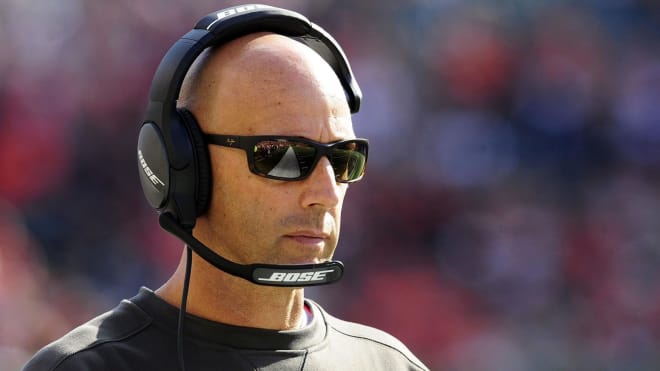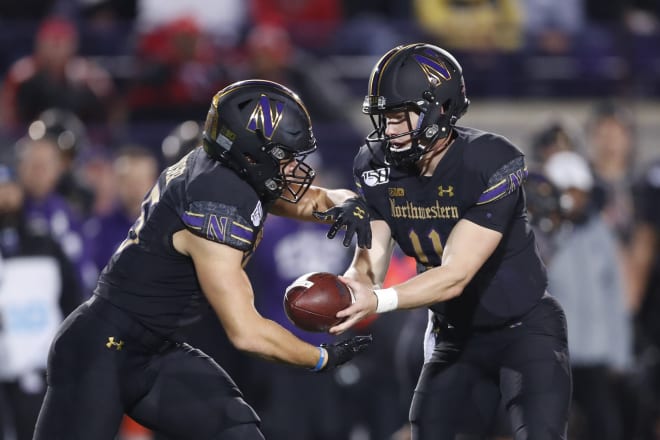Northwestern Spring Primer: Offensive Questions
First in a series of three stories by Tim Chapman examining the questions facing Northwestern's offense, defense and special teams during spring practice.

Snow is in the forecast for Tuesday, but that won't stop Northwestern from starting "spring" practice with its first workout of 2020.
From the offensive side of the football, there is no shortage of questions to answer.
The Wildcats upset Illinois in the 2019 season finale on November 30th, giving them just their third win of the season and their only one in conference play. That was an uncharacteristically low win total for a Pat Fitzgerald-coached team and was due in large part to a pale offense that lacked any kind of consistency or game-changing playmaker.
NU had just 27 plays of 20 or more yards (an average of just over two per game), which was dead last in the NCAA. They scored more than 10 points just twice in their first eight games before tuning up in the final third of the season, where they averaged more than 30 points in their last four, winning two of them and losing one on a last-minute field goal.
So, needless to say, the Wildcats’ primary focus heading into spring ball is to fleetly fix the offensive flaws. Here are three big questions Fitzgerald and his staff will want to address this spring -- and likely into next fall.
1. How much will Mike Bajakian improve the offense

The Wildcats parted ways with 12-yearoffensive coordinator Mick McCall a day after the season-ending win over the Illini. On Dec. 11, they hired 21-year veteran Mike Bajakian from Boston College to direct the Northwestern attack.
Bajakian, a former QB at Williams College (Mass.), has a keen understanding of the position and is known for being pretty good at coaching his quarterbacks to properly fit his system. At BC, his offense averaged 430 yards 31 points per contest, despite having QB injury issues. The Eagles also had the top rushing attack in the Atlantic Coast Conference with RB AJ DIllon, and they placed third in Power Five football in rushing yards per game and also had the best ball security in the conference during the 2019 regular-season.
Prior to his stop in Chestnut Hill, Bajakian served as an offensive assistant with the NFL’s Tampa Bay Buccaneers, leading their offenses to top-five finishes in total offense and passing offense each season. He also coached under Butch Jones (when he was productive) at CMU, and at Cincinnati, helping to lead those two programs to three conference championships in four years under his offensive tutelage.
Some may complain that Bajakian’s projected offensive philosophy isn’t much different than his predecessor McCall's, using pace and tempo and trying to spread the field. The problem for McCall, though, wasn’t with schematics so much as it was the operation of it.
In a dozen seasons calling plays, McCall’s offenses averaged 25 points per game. The Wildcats averaged more than 30 points per game in a season just once in his time as OC, and twice they averaged less than 20 per game, including last year’s miserable 16 ppg output. These offenses placed in the top-half of college football just three times, but three other times they finished in the bottom 20.
In nine total seasons as a college offensive coordinator Bajakian’s offenses, by comparison, have averaged 424 yards and 31.3 points per game. They ranked in the top-40 nationally in total offense seven times; McCall’s units accomplished that feat just once. So it’s safe to say that we can expect some improvement from the point producers on the attack-side.
Bajakian says he’s “not necessarily that smart,” but he recognizes talent and knows how to use it properly.
“We will figure out the playmakers and get the ball in their hands”, he asserts simply.
During the interview process, "Coach Jake" told Fitzgerald that they wouldn’t win games with any magical scheme, but with greater effort than their counterparts -- exactly Fitzgerald’s philosophy since he took the reins as head coach back in 2006.
Bajakian says he wants to have a tough, physical, “smack-you-in-the-mouth” offensive team. He’ll fit right in with the Fitzgerald philosophy of running first, and should team up well with outstanding RB coach Lou Ayeni and the deep core of RBs he’ll have to work with.
2. What will the running back room look like?

Speaking of running the ball, NU has a well-stocked and fairly talented backfield. Junior Isaiah Bowser looks to be the man, but sophomore Drake Anderson (last year’s leading rusher), redshirt first-year Evan Hull and even incoming freshman Cameron Porter will give the Cats plenty of depth behind, and maybe alongside, Bowser, to allow Northwestern to truly be that physical team the coaching staff wants them to be, without having to worry too much about conservation of resources.
Last season, the Wildcats finished 15th nationally in rush attempts per game (44), and 41st in rush yards per game (180), so they’re used to toting the rock. Five RBs with 20-plus carries return from last year, though two of them will be at different positions (WR Kyric McGowan and SAF Coco Azema).
Sure, they averaged just 4.1 yards per carry (78th), but much of that can be attributed to a limited passing attack which allowed defenses to fill the box with extra defenders, making it more difficult to find running room. Only Hull and Anderson averaged more than 50 yards per game rushing, but keep in mind that Bowser was injured and only played in five games. Senior Jesse Brown has shown brief flashes over the last two years but injuries limited him to just four games last season.
Brown was one of three backs that toted more than 20 carries and averaged better than 6 yards a pop; Hull and McGowan were the other two. Look for McGowan to get more carries out of the backfield or on the outside, maybe even in a “Wildcat” role.
Finding the end zone will be something these Wildcat rushers must do a better job of this year. Only two backs had as many as four TDs last season, and one of them was QB Andrew Marty. The other was Hull, and all four of his came in a single game.
Running well was a key to Northwestern’s limited success last year. They cracked 250 rush yards in four games, winning three and losing the other to Purdue on a last-minute field goal. If they can produce more 200-yard ground games, that win total will likely double (or better).
They’ll have the aid of running behind an offensive line that returns four starters and a couple other seasoned players. So if Bajakian can diversify the play-calling enough and decrease the predictability of what’s coming, this corps of running backs should go a long way to reversing the offense's woeful 2019 production.
3. What improvement can we expect from the passing game?

The Wildcats finished 127th in the nation in passing yards per game in 2019, ahead of only Georgia Southern, Army and Navy -- three triple-option teams that throw the ball just a handful of times per game.
It was no secret in and around the football facilities, and certainly among the fans, that the Northwestern passing game was, let’s just call it atrocious. They were near the bottom of almost every relevant passing category, averaging just 117 yards per game through the air, with just six passing TDs in 12 games, while throwing 15 passes into the arms of the wrong jersey.
But theoretical logic would most certainly suggest that the numbers would have to get better this year -- they can't get much worse. And there are many contributing factors to support this.
One is their new offensive play-caller, for reasons stated earlier. Bajakian has a proven track record of getting respectable play out of his quarterbacks and playmakers, and we see that continuing this season in Evanston.
Believe it or not, the Wildcats will have a few quarterbacks competing for the job. Sixth-year veteran T.J. Green was awarded an extra season, and many in Wildcat circles believed last year would have had a different tone had he been healthy enough to play a full season. Green certainly plays with a confidence akin to what we saw in Steve Schnur back in the ‘90s. This could be exactly what an offense needs as they look for their identity.
Junior Hunter Johnson has a lot of arm talent, but we’ll have to see if the mental obstacles that he faced last season (due mainly to personal issues) are truly cleared up and compartmentalized. We know he’s wanting to prove all the skeptics wrong and Fitzgerald right for giving him his chance.
We still think there’s a lot of good in junior Andrew Marty, and he may best fit the mold that former Bajakian quarterbacks have shown -- an ability to use his legs to extend a play rather than just tuck, run and become a scrambler. Marty also brings a certain swagger to the field, which we saw excite his teammates in that emphatic win over Illinois in the finale.
With regard to the quarterback, Bajakian says it’s much less about the measurables and much more about winning. He wants a leader, a director of the offense. This fits well within the Fitzgerald mantra and will be emphasized even more in 2020, following last year’s anomaly of a last-place finish in the Big Ten West.
Once the quarterback situation gets resolved, the Wildcats actually do have a crop of talented wideouts. Six of the top seven receivers return -- it would have been all seven if Bennett Skowronek didn’t transfer -- and every receiver who caught a touchdown comes back to boot.
The leader of the group is senior Riley Lees, who hauled in a team-high 51 receptions in 2019. There was quite the drop-off after him, though; the next highest total was 17 by Ramaud Chiaokhiao-Bowman, who returns for his senior season. As talented as he is, this can’t just be the Riley Lees show. He’ll need to be part of an offensive system that spreads the ball around the way they did in 2018.
The little explosion the Wildcats produced last year came from junior JJ Jefferson and senior McGowan, who are both undersized but showed the ability to get behind, and in-between, the secondary. Junior Berkeley Holman is another returning pass-catcher who could blossom. Hailing from the famed St. John Bosco High School in Bellflower, Calif., Holman is similar to Lees and Flynn Nagel before him -- a slippery route runner who can take a short pass and extend it beyond the sticks. There’s also junior Jace James, who started to come on late last season as a possession-type receiver that quarterbacks liked to find on third down.
This returning production doesn’t even include highly sought-after receiving talents Bryce Kirtz and Genson Hooper-Price, who both redshirted last year and many feel are poised to get into the mix. Keep an eye out for fellow redshirt first-year Wayne Dennis as well.
It should be noted that Bajakian puts emphasis on the TEs, which should help resurrect the superback position that was disappointingly dormant last season, producing just seven receptions for a total of 30 yards and zero touchdowns. If Trey Pugh or Charlie Mangieri or any other one of these guys can emerge, the offense will be much more effective in 2020.
Next up: Defensive Questions.